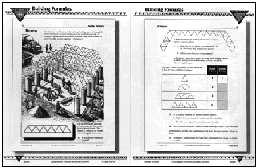- 2 + 2 = reality
- Put away the slide rules. Get out the hang gliders.
The new math is coming to a school near you.
The difference between traditional mathemat-ics education and a new math curriculum for middle schools developed at UW-Madison is the difference between frozen and fluid, between isolation and collaboration, between math as lock-step rules and math as a dynamic way of thinking. The curriculum's name, "Mathematics in Context" (MIC), is apt. It pulls mathematics from its backwater mooring in rote, work-at-your-desk exercises and moves it into the mainstream context of modern life. Some examples: Students explore geometric concepts involving angle through calculating how far a hang glider will fly from various heights at various angles of descent. To learn algebraic concepts, they devise a formula to help a movie set designer calculate how many metal rods are needed for different-length beams. In statistics, students construct systems of classifying pottery unearthed by an archaeologist. During these exercises, students often answer questions together, sharing their problem-solving strategies instead of hunching over their desks and working alone.

By putting mathematics in real-life context, the MIC workbook (above) allows students to reinvent math.
MIC, being published by Encyclopaedia Britannica, was produced by researchers at the university's Wisconsin Center for Education Research (WCER) and curriculum designers at the Freudenthal Institute in the Netherlands. Coordinating the project was Thomas Rom-berg, director of WCER's School Mathematics and Science Achievement Center, who is considered the preeminent leader of a widespread reform movement aimed at changing the way mathematics is taught in the United States. Why the Dutch connection? "The Dutch have been doing 'realistic' math education for years," says Romberg, "so we invited them to work with us." Going Dutch made sense to Romberg. "In international comparisons of student mathematics achievement," he says, "the Dutch students generally rank first or second in the world and are significantly better than American students." In the Netherlands, extensive comparisons have been made between students in "realistic" programs and those in traditional programs. The "realistic" students outperformed the others on 11 of 29 criteria and were comparable on 17 others. Romberg's center worked with the Dutch designers to produce a curriculum suitable for American middle schools, then tested the concept in school districts around the nation. The Dutch-American team made sure that cooperative investigation was a prominent feature of MIC. "If students have an opportunity to reinvent a mathematical idea together," says Romberg, "they're more likely to remember it because they discovered on their own why it was needed." The designers also made the curriculum depart from the traditional by building on and pushing beyond the fundamental skills learned in early levels. "In the past, middle school mathematics has been basically a review and extension of arithmetic," says Romberg. "But MIC incorporates such material as using the ideas underlying statistics and probability, drawing inferences from graphs and spreadsheets, and exploring transformational geometry [turning an object to view it from different angles]," he says. To introduce algebraic concepts, MIC challenges students with problems involving variables. Overall, says Romberg, the strength of the curriculum is the way it recognizes the interconnectedness of mathematical ideas and weaves those ideas into real-life situations.
|
- Work schedules that work
- Employees love flexible work schedules and benefits.
Now, thanks to new research on the productivity
of those arrangements, companies can, too.
Just a few years ago, for a company to experi-ment with an alternative work schedule, such as a four-day, 40-hour week, was a stab in the dark - enough to give a human resources director the heebie-jeebies. But now the process of trying an alternative to the eight-hour day is less confusing and more likely to succeed because of research by a UW-Madison business professor. Research by Randy Dunham and his colleagues helps managers satisfy employee demands for autonomy, independence and flexibility. The team is also helping managers meet company objectives by offering guidelines on how to: evaluate alternative work schedules before choosing one to try;
The bottom-line: Flexible benefits lead to increased
employee satisfaction, especially when the company
communicates the plan clearly to employees
as an aid in making choices.
design, administer and score a survey of employee opinions to help managers anticipate likely employee reactions to various alternative schedules once they would begin (using a set of measures devised by Dunham); and implement and monitor new schedules to maximize the chances for success. Arrangements such as compressed work weeks, flextime and permanent part-time employment aren't as rare in the workplace as you might think: The number of full-time production and service workers with other than eight-hours-a-day schedules increased from 15.9 percent in 1985 to 18.2 percent in 1991. Findings such as these have been compiled into a book titled Alternative Work Schedules, the result of collaboration among Dunham and three other business researchers around the country. Dunham also has done research on flexible or "cafeteria-style" benefits, which allow an employee to choose from a variety of benefits or varying levels of benefits up to a certain cost limit. The bottom-line finding: Flexible benefits lead to increased employee satisfaction, especially when the company communicates the plan clearly to employees as an aid in making choices. Another piece of Dunham's research has looked at shift-work schedules, which affect about one-fourth of the American work force. He studied a police department's switch from an eight-hour-day schedule to a 12-hour day with four days on and four off. He and a colleague discovered that the new schedule allowed the workers to better harmonize their non-work activities with family and community rhythms. Managers have appreciated the real-world connection of Dunham's research. In fact, the Society of Human Resources Management gave Dunham the Yoder-Heneman Best Personnel Research of the Year award - not once, but twice - for his studies.
|


